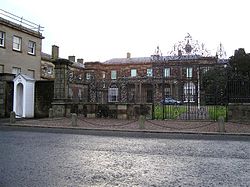Hillsborough, County Down
| Hillsborough, County Down Irish: Cromghlinn | |
| County Down | |
|---|---|
 Hillsborough Castle | |
| Location | |
| Location: | 54°27’43"N, 6°4’59"W |
| Data | |
| Population: | 3,400 |
| Post town: | Hillsborough |
| Postcode: | BT26 |
| Dialling code: | 028 |
| Local Government | |
| Council: | Lisburn and Castlereagh |
| Parliamentary constituency: |
Lagan Valley |

Hillsborough is a village, townland and parish in County Down, situated 12 miles from the city of Belfast.
The historic centre of the village contains significant amounts of Georgian architecture. The village was originally a compact settlement hosting a regular market. More recently land to the north of the village has been developed as housing and Hillsborough has become part of the commuter belt of Belfast. In recent years townhouses and apartments have been built closer to the centre of the village, and the former civic building of Lisburn Borough Council has been converted to residential use. That building is in twentieth century neo-Georgian style. Development to the east of the village is continuing to swell Hillsborough's population. The associated settlements of Culcavy and Aghnatrisk to the north-west are also growing.
A prominent feature of the east and south approaches to Hillsborough is a five-mile wall which encloses the "Park Dam", an artificial lake, and the forest surrounding it.
In 2007 Hillsborough won 3rd place in the Ulster in Bloom large village competition.[1]
History
Before 1661, the townland was known as Crumlin or Cromlin (from the Irish Cromghlinn, meaning "crooked glen"). By 1661 the townland and the settlement within it had been renamed Hillsborough.[2] It was named after Sir Arthur Hill, who built Hillsborough Fort in 1650 to command the road from Dublin to Carrickfergus. The Hill family became the Earls of Hillsborough, then Marquises of Downshire.
A prominent memorial to the 3rd Marquis of Downshire (and closely resembling Nelson's column in Trafalgar Square, London) stands to the south of the village and is visible throughout much of the surrounding area.
Places of interest
- Hillsborough Castle a two-storey Georgian mansion, was Government House from 1924 until 1973 and is the official residence of the sovereign (and other royal family members) when visiting the province and the Secretary of State for Northern Ireland from 1973. Hillsborough Castle was the venue for the signing of the Anglo-Irish Agreement in 1985. Former Prime Minister Tony Blair has stayed at the castle on many occasions during negotiations related to the peace process, and hosted George W. Bush at the Castle for a one-night visit in 2003
- There are many interesting walks and local pubs offering delicacies to enjoy; and is home to a public forest park and lake that form the picturesque setting for the original fort residence of Lord Hillsborough. Hillsborough hosts an International Oyster Festival each year, generally September. This attracts thousands of visitors from as far away as Japan, Russia, the United States and Argentina) The festivities include boat racing, parachuting, garden fêtes, oyster eating and Guinness drinking – all in the name of fun, revelry and charity.
- The historic Parish Church dedicated to Saint Malachy is one of the finest examples of Gothic Revival architecture. It was built by the 1st Marquis of Downshire between 1760 and 1774, in the hope that the church would become the cathedral of the diocese of Down. In addition to its imposing setting, it boasts two 18th century organs,[3] a peal of ten bells and a number of works by notable craftsmen of the era, including the Colours of the County Down Battalion of Carson's Ulster Volunteers. Today it is a vibrant parish in the Church of Ireland Diocese of Down and Dromore.

- Hillsborough is (in somewhat exaggerated terms) said to be the birthplace of the United States – due to a disastrous meeting that took place between Benjamin Franklin and Lord Hillsborough (then the acting Secretary of State for the Colonies) in the early 1770s. They are reported to have hated each other at first sight and, on leaving three days into a week-long visit, Franklin returned home to convince the dissident colonists he represented that there was no alternative but to initiate immediate revolution. The 'Declaration of Independence' in July 1776 followed shortly after Franklin's return.
Notable people
- The composer and conductor Hamilton Harty (1879–1941), whose father William Harty was organist in the Parish Church, was born in Hillsborough.
- Hillsborough was home to TV and radio presenter Gloria Hunniford for a number of years. Her daughter Caron Keating spent much of her childhood in the village.
- Frank Pantridge (1916–2004) was a physician and cardiologist born in Hillsborough, who invented the portable defibrillator.
Railways
The Hillsborough railway station was opened by the Banbridge, Lisburn and Belfast Railway]on 13 July 1863.[4] The line through the station was part of the Great Northern Railway (Ireland) system. The station closed on 30 April 1956 under the auspices of the Ulster Transport Authority.
Sport
- In 2005 Lisnagarvey Hockey Club relocated from their Blaris ground to the outskirts of Hillsborough.
- Downshire Young Men F.C.
| ("Wikimedia Commons" has material about County Down Hillsborough, County Down) |
References
- ↑ http://www.translink.co.uk/20070904ulsterinbloom.asp
- ↑ Placenames NI
- ↑ http://www.lisburn.com/churches/Lisburn-churches/hillsborough-parish-church.html
- ↑ "Hillsborough station". Railscot - Irish Railways. http://www.railscot.co.uk/Ireland/Irish_railways.pdf. Retrieved 2012-05-06.